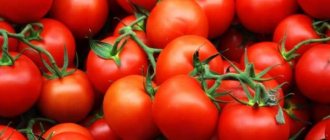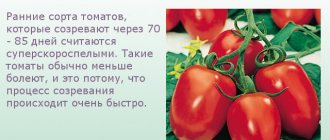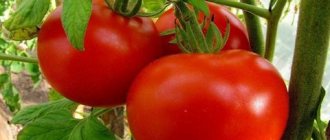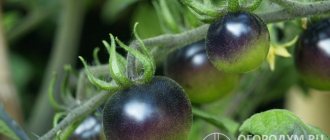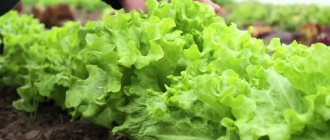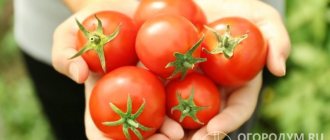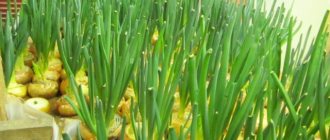Low-growing tomatoes include plants with a bush height of up to 1 m. The latter simply stop growing after the formation of a certain number of inflorescences (from 4 to 8), directing all their forces and nutritional components to the formation of fruits. They are suitable not only for open ground, but also for greenhouses, especially for structures with low height or sloping edges, when insufficient perimeter height does not allow planting tall crops. By choosing the best varieties and following the rules of cultivation, you can please yourself with a good harvest, and thanks to its unpretentiousness in care, it can be obtained with minimal labor costs.
Precocious/early
Many low-growing tomato varieties are characterized by early ripening, which is especially important when grown in regions with short summers. In this category, you should pay attention to the following seeds:
- Pearl. The harvest can be harvested within 87 days after planting in the greenhouse. These will be medium-sized tomatoes weighing 30-40 g. There are three color options: red, pink and yellow. The plants themselves do not require complex care. It is enough to apply complex fertilizers and tie up the trunk so that it does not sag under the weight of ripening fruits.
- F1 doll. A low-growing hybrid with a ripening period of 85 days. On 1 m² of land you can get up to 9 kg of harvest with fleshy, sweet pulp, which can be used for various needs.
- Arctic. An unpretentious variety that tolerates temperature changes and lack of moisture well. Bushes up to 40 cm high do not require a garter and produce up to 25 round small tomatoes each. They begin to bear fruit in 80-87 days.
- "Katya F1". Hybrid with a ripening period of 75-80 days. Productivity reaches 12-14 kg per 1 m². One bunch produces 7-8 tomatoes weighing 90-130 g each. They have a round or flat-round shape, good taste with sweet notes.
- Visible and invisible. An early, low-growing variety with abundant fruiting, therefore, despite its small height (up to 40 cm), it requires a garter. Round, slightly flattened tomatoes are not prone to cracking. They come in two colors: pink and red. The first harvest will be larger (up to 280-330 g), subsequent ones - up to 200-300 g. You can get up to 4-5 kg of vegetables from a bush.
- Sanka. One of the best early varieties. Ripening occurs after 90 days and can last until frost. Productivity reaches 13-15 kg per 1 m². Thanks to their thick skin, the scarlet round fruits are suitable for salads, pickling, and pickling.
Related article:
Tomato Chio-chio-san F1 – description of the popular variety, characteristics and reviews
Plants with a minimum ripening period will also be the best option for greenhouses infected with fungi or bacterial infections: the crop will ripen before the pathogens develop en masse.
Features of growing and caring for tomatoes
Low-growing tomatoes are advantageous because they are undemanding and easy to care for. If you follow the agrotechnical rules for growing nightshade crops, an abundant and high-quality harvest is guaranteed.
Watering mode
Excess moisture threatens tomatoes with the occurrence of late blight, and can also provoke intensive development of tops, which, in turn, will negatively affect fruiting, so the soil should not become waterlogged in the vegetable bed. The same goes for drought.
To prevent the plant from wasting nutrients by increasing unnecessary biomass, it is recommended to water the bed 2-3 times weekly. To avoid burns on the foliage, it is better to do this in the morning. It is advisable to use water at room temperature after standing for a day.
We recommend reading how often and how to properly water tomatoes in a greenhouse.
Fertilizer application
To stimulate good yield, tomatoes need to be fertilized at least 2-3 times during the growing season. For the first time, this procedure is relevant already on the 10th day after planting the seedlings; subsequent feeding should be carried out at two-week intervals. If the bushes grow poorly and form an ovary, additional application of complex minerals is required.
All types of tomatoes develop very well after the root application of a solution of chicken manure or mullein. It is important to observe the measure, since an excess of nitrogen-containing components will provoke vigorous growth of the bush and poor fruiting.
Important! In the spring, when daylight lasts about 13 hours, additionally illuminate the greenhouse. Otherwise, there is a high probability of inhibition in the growth of tomato bushes. Then the first inflorescences will appear not on the 7–8th leaf (as it should be), but on the 13th.
Disease and pest control
The slightest violation of growing technology and improper care are fraught with the development of pathogenic microflora and attacks by harmful insects.
All types of tomatoes are, to varying degrees, sensitive to:
- late blight;
- putrefactive infections;
- anthracnose;
- mosaic;
- cancer pathogens;
- spotting (bacterial and brown).
Diseases can be avoided only if the requirements of plants are met and their development is constantly monitored. Treatment is carried out with fungicides (Maxim, Barrier, Hom, Fundazol).
They like to eat the juices of nightshade crops:
- Colorado potato beetles;
- caterpillars;
- root-knot nematodes;
- whiteflies;
- scoops;
- spider mites.
Insecticides (“Aktara”, “Aktellik”, “Bi 58 - New”) will help get rid of sucking guests.
If parasites have penetrated deeply into the soil, it may be necessary to replace the top layer with further deep plowing. Read more about pests and diseases of tomatoes in a greenhouse.
Large-fruited
The harvest of large-fruited, low-growing tomatoes is usually used for fresh consumption, as well as for the preparation of juices, pastes, and ketchups, but due to its size it is not suitable for whole canning or pickling. For greenhouses, you can choose the following options:
- Gift for a woman. A variety with good yield (up to 30 pieces per bush) and resistance to diseases of nightshade crops. Red-raspberry fruits weighing up to 250 g will be equally good in salads and in juices or ketchup.
- Alsou. The bushes grow up to 80 cm and produce a harvest even in unfavorable weather conditions, but they definitely require garter. Kidney-shaped tomatoes ripen in 105-110 days and weigh up to 500 g (sometimes up to 800 g).
- Big Mama. A young variety that appeared only in 2015. In a greenhouse, fruiting begins 85 days after planting. The average weight of a tomato is 300 g, so a garter is required (and this must be done in advance, since rapid weight gain may damage the stems). Among the features: tolerance to light and cold, mandatory pinching for good yield.
- Openwork F1. An early hybrid resistant to powdery mildew, blossom-end and root rot. The ripening period is 100-110 days, the height of adult bushes is up to 80 cm, the weight of the fruit is up to 400 g (with a bush height of up to 80 cm).
Related article:
If the tips of the leaves dry out on tomato seedlings
Reviews
Everyone has different tastes, but if the varieties are unfamiliar to you, you can read reviews from avid gardeners.
There is a discussion of the Pink Honey variety on the fialka.tomsk.ru forum:
You can read about the Watercolor variety on the tomat-pomidor.com forum:
But, of course, it’s better to try once than to read it 100 times.
Self-pollinating
This category does not require the participation of insects to pollinate plants, which greatly simplifies their cultivation in a greenhouse. Seeds of low-growing tomatoes with similar characteristics include the following varieties:
- Mystery. Bushes 45-50 cm high have a strong trunk. Other advantages include: resistance to many diseases, good development even with a lack of sunlight, and ease of care. The first harvest ripens after 82-88 days. Round tomatoes weigh up to 100 g and hold their shape well, without cracking even with excessive amounts of moisture.
- Gull. A highly productive, disease-resistant variety with a ripening period of 90-98 days. The bushes grow up to 50-70 cm and produce round, slightly flattened fruits weighing 75-80 g, suitable for canning. When creating favorable conditions in the greenhouse, the weight can increase by 100 g.
- Ballerina. The height of adult plants reaches 60 cm. You will have to wait about 105 days before the first harvest. Red pepper tomatoes are distinguished by dense pulp, thin skin and pleasant taste characteristics.
- Pink honey Already from the name you can understand that these will be pink-colored fruits with a sweet taste. Average weight is 600-800 g. Individual specimens reach 1000 g. They are suitable mainly for salads. Productivity is up to 18 kg per 1 m². But plants are susceptible to diseases and therefore require careful care.
You can further increase the number of ovaries on self-pollinating varieties by shaking the stems or using a fan.
Advantages and disadvantages of low-growing tomato varieties
- Determinate (that is, having limited growth) varieties of tomatoes compare favorably with tall ones:
- early fruit ripening;
- simultaneous and abundant fruiting;
- high productivity;
- good taste;
- resistance to pathogenic environments and ease of care;
- unpretentiousness to growing conditions;
- compactness of the bush, which allows the use of any agrotechnical growing technologies.
Despite the numerous advantages of low-growing tomatoes, vegetable growers identify some hybrids that tend to grow stepsons. In turn, this feature negatively affects the quantity and quality of fruits, so timely human intervention is required, which complicates care.
High-yielding
Tomato productivity indicators depend not only on the microclimate of the greenhouse and compliance with plant care rules. There are special low varieties that are predisposed to more intense fruiting compared to their relatives. Among them, the following are well suited for closed ground:
- Rajah. Plants grow up to 100 cm and produce their first harvest after 85-100 days. From 1 m² of plot you can get up to 25 kg of tomatoes. The oblong fruits weighing 200-300 g have dense pulp and a sweetish taste. Well suited for fresh consumption and preparations.
- Grouse. Bushes 50-100 cm high produce up to 15 kg of yield per 1 m². Ripening period – 111 days. Large red tomatoes (up to 300 g) with intermittent yellow stripes have a sweetish taste. Due to their resistance to cracking, they are suitable for fresh storage, as well as canning and pickling.
- Golden domes. From one bush you can get up to 11 kg of large fruits with excellent taste characteristics and presentation. The average weight is 400 g, with good care - up to 800 g. But you will have to wait up to 3.5 months before they ripen.
- Tanya F1. Compact bushes up to 60 cm high have delicate stems, so they require tying, and in the process of ripening tomatoes, installation of supports. They produce up to 5 kg of tomatoes weighing about 150 g each.
Related article:
Tomato Kiss - description and characteristics of an early ripening variety
How to protect yourself from a bad seed purchase
To protect yourself from an unsuccessful purchase of seed, follow a number of simple rules:
- Before going to the store, consult with your summer residents. Find out what seeds they use and what crops they grow. If this is not possible, read several topical articles;
- study photographs of ready-made tomatoes on the Internet, mark for yourself the varieties that you like most;
- do not buy seeds from random sellers - it is better to go to a specialized store;
- ask the sales consultant all your questions;
- pay attention to the manufacturer - it is better to study reviews about it on the Internet in advance;
- read the information on the package - ripening period, characteristics, methods of care. Find out in which region of our country the variety will give the best harvest.
Without stepsoning
Removal of stepsons is carried out in order to increase productivity. But if you don’t have time for such activities, you can purchase seeds of low-growing tomatoes, which will not need this procedure during the growing process.
- Watercolor. The bushes grow up to 50 cm, show resistance to drought and various diseases (including rot). They begin to bear fruit in 115-120 days. Elongated tomatoes weighing 80-120 g with thick skin and juicy pulp are suitable for salads, sauces, pasta and winter preparations. Also suitable for long distance transportation.
- Red Fang. Among the advantages of the variety: unpretentiousness, disease resistance and good yield. On day 85-95 you can get sweet, bright red tomatoes with dense flesh, suitable for fresh salads and canning.
- Duckling. Plants do without pinching, but require staking. They are valued for their disease resistance and fruit production, regardless of weather conditions. Bright orange tomatoes with a “spout” are characterized by a weight of 70-90 g and a high content of beta-carotene and sugars.
- Little Red Riding Hood. The variety came to Russia from Germany, where it is known as Rotkäppchen. Bushes up to 70 cm high do not require staking due to strong stems and produce up to 2 kg of harvest. You can count on your first collection in 95 days. Each bunch produces 4-5 red-orange tomatoes weighing about 50 g each. They have a round shape with slight ribbing.
Related article:
Caring for tomatoes in greenhouse conditions
Tips for summer residents: The benefits of pinching tomatoes and timing
Harvest and storage times
Depending on the breeding characteristics, the ripening time of tomatoes varies. For some, the growing season lasts about 82 days, while for others it lasts within 130 days. Also, the size of the fruit, its juiciness, the structure of the pulp, the density of the peel, and, accordingly, transportability and storage methods depend on the variety.
If you have to deal with early tomatoes, they are often used for consumption raw. Large, fleshy fruits are processed into juice, adjika, and ketchup, while small and medium-sized fruits are canned or salted whole.
When the harvest period begins, the fruits must be carefully removed from the stems, avoiding cracking and mechanical damage to them. Specimens with thick, elastic skin can be transported over long distances, while more delicate ones are not suitable for such manipulations.
If you want to keep the fresh product until late autumn, you can collect the tomatoes in a box and place it in the cellar, covered with a warm cloth. Fruits that do not have time to ripen in time are more suitable for this.
Among low-growing tomatoes, there are many varieties to suit every taste. We hope our article helped you decide on the best options.
Late
Low-growing varieties intended for late harvesting are suitable for long-term storage of fresh tomatoes and other needs. In this category, you should pay attention to the following options:
- Titanium. Round, small fruits (up to 120 g) ripen in 135 days and can be used for all types of preparations. Adult plants grow no more than 50 cm, are resistant to fungi and other tomato diseases, are not sensitive to moisture deficiency, but require fertilizing during the period of active growth, gartering of trunks and do not respond well to a sharp drop in temperature.
- Rocket. Low bushes are resistant to all types of rot. Ripening occurs in 120-130 days. Per 1 m² you can collect up to 6-10 kg of elongated oval tomatoes weighing 50-60 g. They are suitable for canning, pickling, as well as long-term storage and transportation without loss of presentation.
- Finish. Gives a harvest in 130-135 days. Intensely red fruits weighing up to 90 g with juicy pulp have a dense skin that prevents them from cracking. They are distinguished by good keeping quality and transportability.
- Bobcat. A hybrid of Dutch origin with a growing season of 120-130 days, resistant to adverse weather conditions (including drought) and most diseases of nightshade crops. On bushes 50-70 cm high, slightly flattened tomatoes weighing up to 250-300 g ripen.
Criterias of choice
Typically, each gardener chooses short tomatoes based on his own preferences for ripening time, size and color of the fruit, and taste characteristics. In addition, several other factors should be taken into account:
- Features of the greenhouse. For summer buildings (for example, made of cellular polycarbonate), it is better to choose early-ripening varieties that are resistant to temperature changes or extreme heat. For heated winter rooms, you should pay attention to options with a short growing season and tolerance to a lack of sunlight. If there are problems with water supply, you need to plant plants that are drought-resistant and not prone to cracking.
- Growing goals. For personal needs, it is enough to focus on your tastes; for subsequent sales, give preference to high-yielding and transportable varieties.
Related article:
Secrets of growing tomatoes from experienced gardeners
- Purpose of tomatoes. It is advisable to decide in advance on the required quantity of early vegetables and those that will be used for storage and preparation, including separately for their different types. For example, for whole-food preservation it is worth focusing on small- and medium-fruited varieties; for fresh salads, processing into tomato juice and similar products, large fruits are suitable.
- Disease prognosis. In closed ground, pathogenic microorganisms accumulate more, and when growing only tomatoes in a greenhouse for several seasons in a row (without crop rotation), the risk of infectious diseases increases significantly. In this case, it is recommended to pay attention to the latest disease-resistant hybrids. And when choosing non-hybrid forms, you need to think through the process of disinfecting seeds and the greenhouse, ventilation and subsequent treatments.
Read about varieties of low-growing tomatoes for open ground in the article
How to properly form low-growing tomatoes in a greenhouse
Determinate varieties are best formed into 2 stems. In this case, it is recommended to remove the lower foliage to ventilate the root zone. In addition, this will make it easier to water and fertilize vegetables.
Varieties that are prone to the growth of stepsons require their timely removal. Please note that extra shoots never appear on the stems; they must be looked for in the leaf axils.
Did you know? A record-breaking tomato was grown in Wisconsin (USA). The fruit was the size of an average watermelon and weighed almost 3 kilograms.
When growing low-growing tomatoes in a greenhouse, a larger number of flower clusters can be left. The microclimate of polycarbonate and other shelters will allow the formed ovary to ripen in time.
It is advisable to lighten bushes that do not require pinching well and constantly monitor the level of moisture in the soil and room, otherwise late blight cannot be avoided.
The need for installation of supports and garter may arise only in specimens that develop to a height of 1 m and have thin, fragile stems. In this case, in order not to damage the tops, it is advisable to use a soft fabric tourniquet as a garter.
